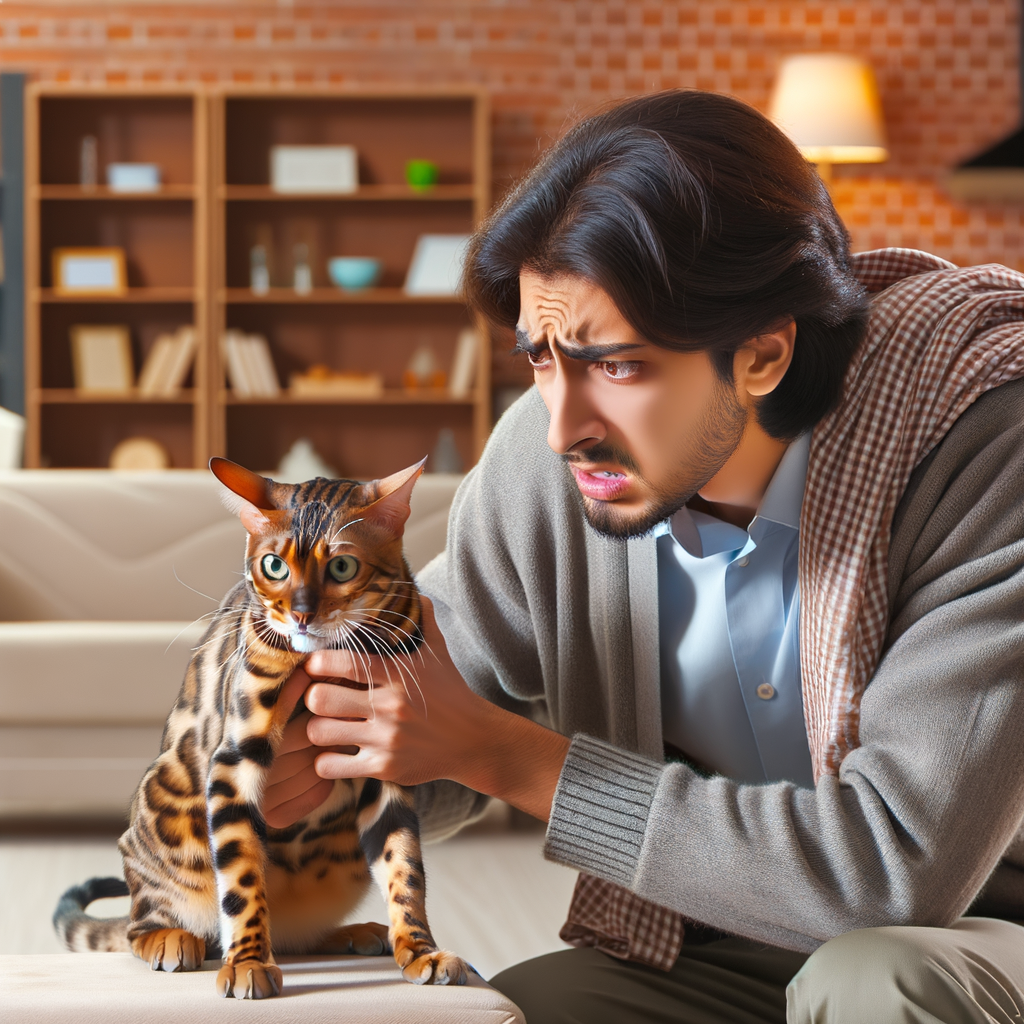
Bengal Cat Aggression
- Defining aggression in Bengal cats: Aggression in Bengal cats can show up in many ways. It might be hissing, biting, or scratching. These actions can be scary but understanding them is the first step to solving the problem.
- Common triggers of Bengal cat aggression: There are several things that can make a Bengal cat act aggressively. Some common triggers include:
- Fear: If a Bengal cat feels scared, it might lash out.
- Territorial behavior: Bengals can be very protective of their space.
- Overstimulation: Sometimes, too much petting can lead to a sudden bite or scratch.
- Health issues: Pain or illness can make a cat more likely to be aggressive.
- The Bengal cat temperament: Bengal cats are known for being active and playful. They are also very intelligent. This means they need a lot of mental and physical stimulation. Without it, they can become bored and may act out. Knowing this can help you provide a better environment for your Bengal cat.
| Trigger | Explanation |
|---|---|
| Fear | Feeling scared can make a Bengal cat aggressive. |
| Territorial behavior | Bengals protect their space and may act out if they feel it is threatened. |
| Overstimulation | Too much petting can sometimes lead to aggression. |
| Health issues | Pain or illness can make a cat more likely to be aggressive. |
Managing Bengal Cat Aggression
Preventing Bengal Cat Attacks
- Recognizing warning signsLook for behaviors like hissing, growling, or a puffed-up tail. These signs indicate that your cat may be feeling threatened or stressed.
- Creating a safe environmentProviding a safe and comfortable environment can reduce aggression. Ensure your Bengal cat has plenty of space to roam and play. Cats need their own territory to feel secure.
Consider setting up multiple hiding spots and high perches. These areas allow your cat to retreat when feeling overwhelmed. A safe environment can make a big difference in your cat’s behavior.
| Warning Sign | What It Means |
|---|---|
| Hissing | Feeling threatened or scared |
| Growling | Warning to stay away |
| Puffed-up tail | Trying to appear larger and more intimidating |
| Flattened ears | Ready to attack or defend |
Reducing Bengal Cat Aggression
- Effective calming techniquesCalming a Bengal cat can be challenging, but there are effective methods. One technique is to use pheromone diffusers. These devices release calming scents that help reduce stress. Another method is to create a quiet space where your cat can retreat when feeling overwhelmed.
According to a study by the ASPCA, cats with access to a safe space are less likely to show aggression.
- Importance of regular exerciseThese cats are very active and need plenty of playtime. Interactive toys like feather wands and laser pointers can help keep them engaged.
Experts recommend at least 30 minutes of playtime each day to keep your Bengal cat happy and healthy. This not only reduces aggression but also prevents obesity and other health issues.
- Role of a balanced dietA balanced diet plays a significant role in managing aggression. Feeding your Bengal cat high-quality food can improve their mood and behavior.
| Technique | Benefits |
|---|---|
| Calming Techniques | Reduces stress and provides a safe space |
| Regular Exercise | Keeps the cat engaged and prevents obesity |
| Balanced Diet | Improves mood and overall health |
Bengal Cat Aggression Solutions
Dealing with Bengal Cat Aggression
- Professional help: When to seek itIf your Bengal cat’s aggression is severe, it may be time to seek professional help. A veterinarian or a cat behaviorist can provide expert advice. They can help identify any underlying medical issues or behavioral problems.
- Training tips for aggressive Bengal catsTraining your Bengal cat can help reduce aggression. Here are some tips:
- Positive Reinforcement: Reward good behavior with treats or praise. This encourages your cat to repeat those actions.
- Consistent Routine: Keep a regular schedule for feeding, playtime, and rest. This helps your cat feel secure and less stressed.
- Avoid Punishment: Punishing your cat can increase fear and aggression. Instead, redirect their behavior with toys or activities.
Bengal Cat Socialization Techniques
- Introducing new people and pets
Start by letting your cat see the new person or pet from a distance. Gradually bring them closer over time. This helps your Bengal feel safe and less stressed.
For example, if you have a new dog, keep the dog on a leash and let your cat observe from a safe spot. Reward your cat with treats for calm behavior. This positive reinforcement helps your Bengal associate new friends with good things.
- Teaching appropriate play behavior
Use toys to play with your cat, not your hands. This prevents your Bengal from thinking it’s okay to bite or scratch you.
If your cat gets too rough, stop playing and walk away. This shows your Bengal that rough play means no more fun. Over time, your cat will learn to play gently.
How to Calm an Aggressive Bengal Cat
Bengal Cat Behavior Problems
- Identifying Common Behavior ProblemsBengal cats are known for their high energy and intelligence. However, they can sometimes show aggressive behavior. Common problems include:
- Scratching furniture
- Hissing and growling
- Attacking other pets or people
-
The Causes Of Behavior Problems
- Lack of stimulation: Bengals need lots of play and mental challenges.
- Territorial behavior: They may feel the need to defend their space.
- Fear or anxiety: Changes in their environment can make them uneasy.
-
Effective Solutions
- Provide plenty of toys: Interactive toys can keep them busy and happy.
- Create a safe space: A quiet area where they can retreat can help reduce stress.
- Use positive reinforcement: Reward good behavior with treats and praise.
| Problem | Cause | Solution |
|---|---|---|
| Scratching furniture | Lack of stimulation | Provide scratching posts and toys |
| Hissing and growling | Fear or anxiety | Create a safe space |
| Attacking other pets or people | Territorial behavior | Use positive reinforcement |
Bengal Cat Temperament Management
- Importance of Patience and ConsistencyManaging a Bengal cat’s temperament requires patience and consistency. These cats are intelligent and active, which means they need regular interaction and stimulation. Consistent routines help them feel secure and reduce anxiety.
For example, feeding your Bengal cat at the same time each day can create a sense of stability. Similarly, playtime should be scheduled regularly to keep them engaged and happy.
- Using Positive ReinforcementPositive reinforcement is a powerful tool in managing Bengal cat behavior. Rewarding good behavior with treats, praise, or playtime encourages them to repeat those actions.
For instance, if your Bengal cat uses the scratching post instead of furniture, immediately reward them with a treat.
- Case Study: Successful Temperament ManagementConsider the case of Max, a Bengal cat who exhibited aggressive behavior. His owner, Sarah, implemented a structured routine and used positive reinforcement techniques. Over time, Max’s behavior improved significantly.
Sarah’s approach included:
- Feeding Max at the same times each day.
- Engaging in daily play sessions with interactive toys.
- Rewarding Max with treats for calm behavior.
Within a few months, Max became more relaxed and less aggressive, showcasing the effectiveness of patience, consistency, and positive reinforcement.






